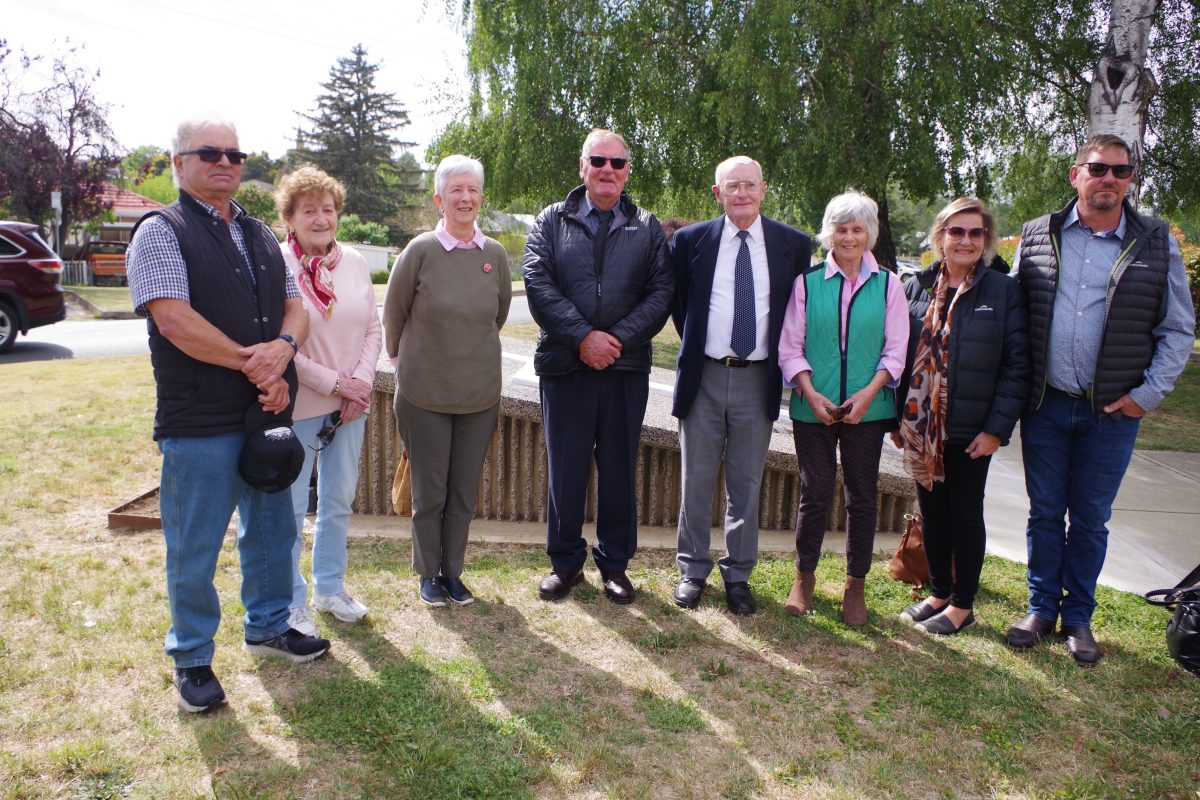
Rescuer Gino Cerro, nurses Rob Piccone and Therese Ferguson, Peter Smith, receiving doctor John Price, Cabramurra nurse Pippa Robinson, Sue and Tim Smith. Photo: Gail Eastaway.
Fifty years ago, the Snowy Mountains witnessed one of the worst bus accidents in Australian history.
Eighteen people lost their lives, and the event changed the lives of many others.
Snowy Hydro recently coordinated the dedication of a plaque to the memory of the victims.
The ceremony was attended by family of the victims, Snowy personnel, some of the medical staff who were involved in treating the injured, members of Cooma Lions Club who maintain the site of the plaque and other members of the public.
The Tumut Pond bus crash was front page news across the nation.
On 16 September 1973, the Brighton Senior Citizens Club from South Australia was enjoying a bus trip to the Snowy Mountains.
The bus was en route from Khancoban to Cabramurra and Cooma with 39 passengers on board.
At about 2:30 pm, approaching Tumut Pond Dam, the driver, 25-year-old James Ogilvie, realised he had no brakes. He tried a number of things to slow the bus as it sped down the steep road, including driving it into an embankment, but nothing worked.
The bus rolled, cutting off its top section, and plunged into the dam, and in the process, passengers were thrown from the vehicle and many ended up in the water.
The accident was reported by Snowy worker Graham Nutt, who was driving from Cabramurra to Tumbarumba. He drove to Tooma Dam where he was able to call Cabramurra to raise the alarm, setting up an amazing response.
Senior Works Supervisor with Snowy Mountains Authority, Harry Cross coordinated the rescue efforts at Cabramurra, setting personnel off to perform specific tasks.
Cooma doctor, Dr West, was flown as far as Adaminaby, as the weather conditions prohibited aircraft landing at Cabramurra.
According to the then Cabramurra Medical Centre head nurse Pippa Robinson, the whole town of Cabramurra pulled together to help.
At the time, Pippa was heavily pregnant with twins.
Women arrived to help, and some looked after the town’s children to allow others to assist.
The men from the town formed a human chain at the site to help bring the injured up the steep slope and into Cabramurra where they were triaged and treated by Pippa and her colleagues.
Workers from the Snowy, Civil Defence, the police, ambulance and AV Jennings Construction Company all pitched in to help. Boats were used to retrieve people from the dam. Other motorists also stopped to assist.
A shed on site was turned into a temporary morgue, while the injured were recovered, assessed and sent on to Cooma Hospital.
The less severely injured were transported by car, some meeting the ambulances on the way.
Pippa said the event had been traumatic for everyone, but everyone just got on with what needed to be done.
The alarm reached Cooma District Hospital and according to the then assistant tutor at the hospital, Sister Pam Newell, “matron Dora Theunissen immediately implemented the hospital disaster plan. All staff in the sisters’ home and nurses’ home were alerted and placed on call”.
In a paper Ms Newell wrote for the Australian Nurses Journal in 1974, she described how matron Theunissen and the hospital’s chief medical officer Jim Doyle, went about setting up the hospital to take an unknown number of casualties.
This included adding beds to male and female wards, reorganising the casualty department to cater for more patients, having medical technicians and x-ray ready and alerting the town’s clergy.
Nurses, student nurses and nurse aides were all on call.
The first patients arrived about 5:45 pm and were met in casualty by two doctors assisted by two staff nurses, plus an extra staff nurse, office staff and nurse aide. Patients were tagged with their names and drugs given and matron Theunissen directed them to the appropriate bed.
Sr Newell reported: “As patients were moved through casualty, they were assessed by one of the two doctors, given immediate care, channelled through the x-ray department to the wards. The medical technologist moved around the wards following up doctors’ pathology requests. Four doctors circulated checking patients and giving follow-up care.”
The last patient, James Ogilvie, was admitted at 9:15 pm.
Two operating theatres opened at 10:30 pm and two theatre teams operated on six cases until they were completed at 1 am.
In the days that followed, patients received ongoing care, including physiotherapy. They remained in Cooma Hospital until they were well enough to travel home.
Sr Newell concluded in her report: “The whole procedure of admitting 21 casualty patients went off very smoothly due to the co-ordination of the many ambulance services involved and the efficient direction of patients to wards from casualty by matron.
“Due to the critical lack of space both in casualty and x-ray departments, smoothness and efficiency of activity was absolutely essential.”
The subsequent coronial inquiry into the accident found the cause to be brake failure.







